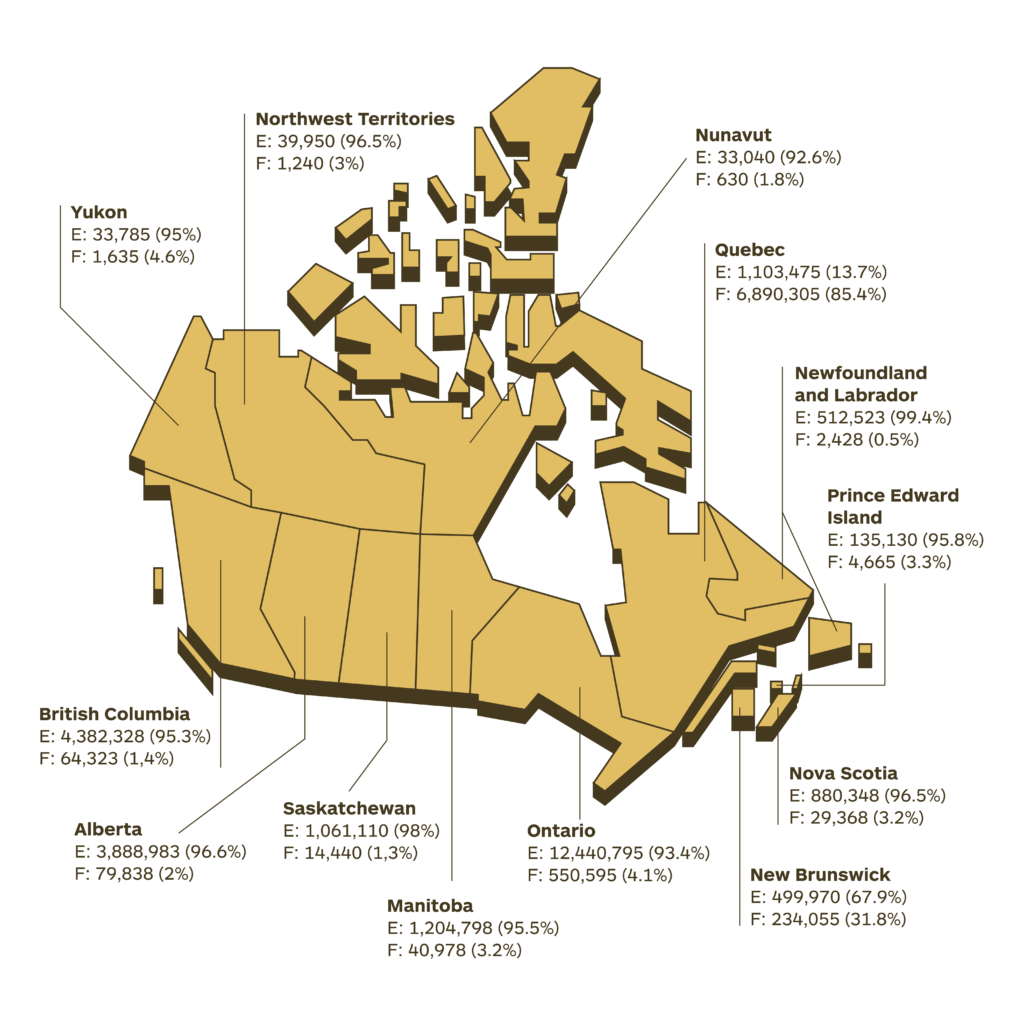Language

In 2011, Canadians who spoke the two official languages in Quebec had average annual incomes of approximately 37% higher than those who spoke only one official language. Similarly, in the rest of Canada, the average annual income of individuals who spoke both official languages was approximately 15% higher than that of persons who did not speak both official languages
(National Household Survey, Statistics Canada: 2011).

Imminent Annual Report 2021
Fit your business in global shape. Get your copy of Imminent Annual Research Report 2021. And let us know what you think.
Get your copy nowA recent Canadian study by by Zenaida R. Ravanera on Citizenship and Immigration Canada found that Francophone bilingual immigrants (first official language spoken – FOLS) outside of Quebec fare better economically than Anglophone bilingual immigrants, although they tend to be less well integrated socially. Within Quebec, the opposite was true, Anglophone bilingual immigrants fare better economically than Francophone bilingual immigrants, although they are less well integrated socially. Based purely on an analysis of supply and demand, this stands to reason, with the relative abundance of Francophones in Quebec, and of Anglophones in other parts of Canada. In other words, the relative scarcity of Francophones outside of Quebec increases their value, similarly to Anglophones within Quebec, however it also raises interesting questions regarding social integration.
Top 20 Canadian cities where bilingual candidates have a competitive advantages
| Rank | City | Province | Rank | City | Province |
| 1 | Toronto | Ontario | 11 | Ottawa | Ontario |
| 2 | Guelph | Ontario | 12 | Brantford | Ontario |
| 3 | Montreal | Quebec | 13 | Quebec City | Quebec |
| 4 | Kitchener | Ontario | 14 | Saint John | Newfoundland |
| 5 | Fredericton | New Brunswick | 15 | Winnipeg | Manitoba |
| 6 | Hamilton | Ontario | 16 | Vancouver | British Columbia |
| 7 | Regina | Saskatchewan | 17 | Oshawa | Ontario |
| 8 | Moncton | New Brunswick | 18 | Edmonton | Alberta |
| 9 | Halifax | Nova Scotia | 19 | Kingston | Ontario |
| 10 | London | Ontario | 20 | Cornwall | Ontario |
Top 10 occupations in Canada where bilingual candidates have a competitive advantages
| Rank | Occupation | Functional area |
| 1 | Billing administrator | Finance/Accounts |
| 2 | Collections clerk | Finance/Accounts |
| 3 | Financial administrator | Finance/Accounts |
| 4 | Technical support/Customer service | IM/IT |
| 5 | Human resources advisor | Human resources |
| 6 | Marketing coordinator | Sales and marketing |
| 7 | Systems administrator | IM/IT |
| 8 | Recruitment consultant | Human resources |
| 9 | Administrative assistant | Administration |
| 10 | Sales representative | Sales and Marketing |
It seems that bilingual workers outside Quebec generate 10% of Canadian GDP outside Quebec. In addition, bilinguals generate around 20% of GDP in educational services and in public administration outside Quebec. In Canada, of the 28.6 million people aged 15 or over in 2016, some 5.4 million considered themselves bilingual. This represents nearly 19% of the working age population. Taking into consideration only those who were employed, the proportion rises to 20.4%. In other words, more than one fifth of Canadian workers were bilingual in 2016. To no one’s surprise, a majority (60%) of bilingual Canadians live in Quebec, but bilinguals can also be found in large numbers in Ontario, British Columbia, and New Brunswick. This suggests that bilingualism is found more among francophones than among anglophones.

A majority of bilingual Canadians ive in Quebec or Ontario
(geographic distribution of bilingual Canadians aged 15 or older, per cent)
Source: Statistics Canada; The Conference Board of Canada
Bilinguals are more educated
(level of education by official languages proficiency in 2016, per cent)
| College or cègep | Bachelor’s | Master’s | Doctorate | Other post graduate | All university certificates and degree | |
| Anglophones | 20.5 | 15.8 | 4.4 | 0.7 | 1.5 | 25.8 |
| Francophones | 14.3 | 6.7 | 1.4 | 0.2 | 0.9 | 12.2 |
| Bilinguals | 19.7 | 20.4 | 7.6 | 1.5 | 2.7 | 36.6 |
Of the three groups examined here – anglophone monolinguals, francophone monolingual, and bilinguals – bilinguals had the highest participation rate and the lowest unemployment rate in 2016.
Bilingual participating in the labour market
(participation and unemployment rate, per cent)
| 2006 Participation rate | 2016 Participation rate | 2006 Unemployment rate | 2016 Unemployment rate | |
| Anglophones | 67.6 | 65.8 | 6.4 | 7.9 |
| Francophones | 59.7 | 56.2 | 7.3 | 7.8 |
| Bilinguals | 72.6 | 71.2 | 6.4 | 7.0 |
What is more interesting, however, is that bilinguals are over-represented in public administration; cultural industries; wholesale trade; educational services; arts, entertainment, and recreation; professional, scientific, and technical services; and finance and insurance.
Bilingual Workers Are Over-Represented in Public Administration
(share of bilingual workers by industry, per cent)
Source: Statistics Canada; The Conference Board of Canada
While over 20% of Canadian workers are bilingual, the proportion falls to 10.3% when the data are limited to Canada outside Quebec. This could be indicative of the fact that in a bilingual economy, there are more economic advantages to learning the dominant language than there are to learning the minority language – One can imagine that a Quebec francophone can see more economic potential in learning English than an Alberta anglophone would see in learning French.
The majority of bilinguals outside Quebec live and work in Ontario
(Geographic distribution of bilinguals outside Quebec in 2016, per cent)
Source: Statistics Canada; The Conference Board of Canada
As with bilinguals across Canada as a whole, those outside Quebec graduate from university at an above-average rate. In 2016, 24.1% of the population aged 15 or older outside Quebec had at least a bachelor’s degree. Among bilinguals, the proportion rose to 37.%. Among anglophone monolinguals, it was 23.1%.

Bilinguals in Canada Outside Quebec Stay in School Longer
(Percentage of those with a bachelor’s degree or higher among those aged 15 or older, 2016)
Source: Statistics Canada; The Conference Board of Canada
In every province except New Brunswick, the share of bilinguals with at least a bachelor’s degree is higher than the average for all Canadians outside Quebec (24.1%).
Bilinguals Earn More Almost Everywhere
(average income, $ millions)
Source: Statistics Canada; The Conference Board of Canada
Lastly, with respect to participation and unemployment rates, bilinguals are also well-placed, with a higher participation rate than anglophones in every province. Bilinguals are also less affected by unemployment, except in British Columbia.
Bilinguals outside Quebec are active in the labour market (2016)
| Participation rate: bilinguals | Participation rate: anglophones | Unemployment rate: bilinguals | Unemployment rate: anglophones | |
| British Columbia | 69.5 | 64.7 | 7.0 | 6.6 |
| Alberta | 76.3 | 72.1 | 8.4 | 9.0 |
| Saskatchewan | 73.3 | 68.3 | 6.3 | 7.1 |
| Manitoba | 71.6 | 66 | 5.9 | 6.8 |
| Ontario | 69.4 | 65.4 | 7.4 | 7.4 |
| New Brunswick | 66.6 | 60.3 | 10.7 | 10.9 |
| Nova Scotia | 69.4 | 60.4 | 9.1 | 10.1 |
| Prince Edward Island | 70.3 | 66.0 | 11.3 | 12.4 |
| Newfoundland and Labrador | 70.2 | 58.1 | 12.0 | 15.8 |
| Canada | 71.7 | 65.8 | 7.0 | 7.9 |
What sectors do they – workers and bilingual workers – work in outside Quebec?
(workers and bilingual outside Quebec by sector, 2016, per cent)
| Proportion of workers outside Quebec | Proportion of bilingual workers outside Quebec | |
| Agriculture, forestry, fishing and hunting | 2.3 | 1.5 |
| Mining, quarrying, and oil and gas extraction | 1.6 | 1.4 |
| Utilities | 0.7 | 0.6 |
| Constructions | 7.0 | 4.9 |
| Manufacturing | 7.4 | 4.8 |
| Wholesale trade | 3.3 | 2.6 |
| Retail trade | 10.6 | 9.1 |
| Transportation and warehousing | 4.5 | 3.4 |
| Cultural industries | 2.1 | 2.6 |
| Finance and insurance | 4.0 | 4.1 |
| Real estate services | 1.7 | 1.3 |
| Professional, scientific and technical services | 6.6 | 7.6 |
| Enterprise managemanet | 0.2 | 0.2 |
| Administrative and support services | 4.0 | 3.3 |
| Educational services | 6.9 | 12.1 |
| Healthcare and social assistance | 10.4 | 10.3 |
| Arts, entertainment and recreation | 2.0 | 2.7 |
| Accommodation and food services | 6.7 | 6.4 |
| Other services | 4.0 | 3.5 |
| Public administration | 5.9 | 11.2 |
Furthermore, bilinguals are often under-represented in the goods-producing industries (e.g., manufacturing, construction, the primary and utilities sector) in most provinces. The exception is Ontario, where 25.3% of workers in mining are bilingual (as compared with 11.5% of all Ontario workers). This could be indicative of two factors: employers in the services sector appreciate linguistic assets more than employers in the goods sector; or more bilinguals elect to seek jobs in the services sector. In reality, both factors are probably apply. Furthermore, given that a large proportion of bilinguals pursue post-secondary education, and given that they choose to study business administration, public administration, social sciences and law, it is not surprising that they are more numerous in the service industries than in the goods producing industries.

Bilingual are not numerous in legal services (bilingual workers as a share of all workers in legal services in 2016, number and per cent)
| Number of bilingual workers in legal services | Total number of worker in legal services | Bilingual workers as a proportion of all workers in legal services (per cent) | |
| Newfoundland | 95 | 1,305 | 7.3 |
| Prince Edward Island | 70 | 450 | 15.6 |
| Nova Scotia | 485 | 3,415 | 14.2 |
| New Brunswick | 890 | 2,010 | 44.3 |
| Ontario | 10,850 | 70,885 | 15.3 |
| Manitoba | 430 | 3,600 | 11.9 |
| Saskatchewan | 265 | 3,105 | 8.5 |
| Alberta | 1,745 | 16,740 | 10.4 |
| British Columbia | 2,685 | 23,455 | 11.4 |
| Total for Canada outside Quebec | 17,600 | 125,320 | 14.0 |
Bilinguals Generate More Wealth Almost Everywhere
(per capita GDP, $ 000s)
Source: Statistics Canada; The Conference Board of Canada
It is in public administration that the contribution of bilinguals outside Quebec is most strongly felt. They account for more than one-fifth of output in that sector outside Quebec. Next is the educational services sector, where bilinguals generate 18.4% of output. And in third place is the cultural industries sector, where bilinguals generate 13.2% of output.
Another finding is that, as is the case for Canada as a whole, the output of bilinguals outside Quebec is concentrated in finance, insurance, and real estate services. Of the $134.8 billion generated by bilinguals in 2016, 22.% was in finance, insurance, and real estate services, 13.3% in public administration, and 9.5% in educational services. This suggests that bilinguals working in finance, insurance, and real estate services are more productive than those who work in public administration or educational services, given that educational services employs 12.1% of bilinguals, public administration employs 11.2%, and finance, insurance, and real estate services employs 4.1%.
ReportConferenceBoard_BilingualismQC-EN
Photo credits: Ali Tawfiq, Unsplash / Juli Moreira, Unsplash / Lilian, Unsplash / Michael Descharles, Unsplash
